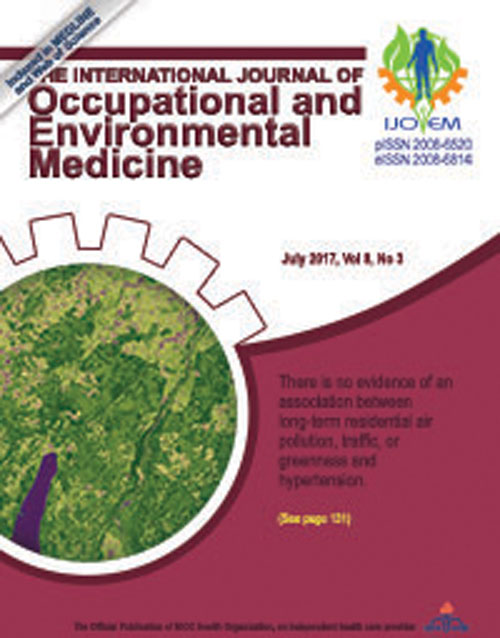فهرست مطالب

International Journal of Occupational and Environmental Medicine
Volume:8 Issue: 3, Jul 2017
- تاریخ انتشار: 1396/05/25
- تعداد عناوین: 9
-
-
Pages 131-142BackgroundThe public health burden of hypertension is high, but its relationship with long-term residential air pollution, road traffic, and greenness remains unclear.ObjectiveTo investigate associations between residential air pollution, traffic, greenness, and hypertension among mothers.MethodsInformation on doctor-diagnosed maternal hypertension was collected at the 15-year follow-up of two large population-based multicenter German birth cohortsGINIplus and LISAplus (n=3063). Residential air pollution was modelled by land use regression models within the ESCAPE and universal kriging within the APMoSPHERE projects. Road traffic was defined as traffic load on major roads within a 100-m buffer around residences. Vegetation level (ie, greenness) was defined as the mean Normalized Difference Vegetation Index in a 500-m buffer around residences and was assessed from Landsat 5 TM satellite images. All the exposure variables were averaged over three residential addresses during the last 10 years and categorized into tertiles or dichotomized. The individual associations between each of the exposure variables and hypertension were assessed using logistic regression analysis.ResultsNo significant and consistent associations across different levels of adjustment were observed between the exposures of interest and hypertension. The only significant estimate was found with coarse particulate matter concentrations (OR 1.66, 95% CI 1.01 to 2.74; 3rd vs 1st tertile) among mothers residing in the Wesel area. No significant associations were observed with traffic load or greenness.ConclusionThis study does not provide evidence on detrimental effects of air pollution and road traffic or beneficial effects of greenness on hypertension among German adults.Keywords: Hypertension, Air pollution, Cohort studies, Satellite imagery, Geographic information systems, Remote sensing technology, Risk factors
-
Pages 143-152BackgroundAlthough the effect of temperature on the incidence of acute myocardial infarction (AMI) has been extensively documented, no study has previously investigated the association between temperature and AMI in the Middle Eastern countries.ObjectiveTo examine the association between daily mean temperature and AMI admission rates in Tehran, Iran.MethodsData on daily number of admissions of patients with AMI to Tehran hospitals between March 21, 2013 and March 19, 2016, were retrieved from the Iranian Myocardial Infarction Registry (IMIR). Over the same period, data on daily mean temperature and relative humidity were measured at Mehrabad International Airport weather station of the Islamic Republic of Iran Meteorological Organization. Time-stratified case-crossover design was employed to investigate the short-term association between the daily mean temperature and the number of daily admissions of patients with AMI, after adjusting for public holidays, relative humidity, and air pollution.ResultsAn interquartile range (IQR) increase in daily mean temperature was associated with 15.1% (95% CI 1.3 to 30.8%) and 13% (95% CI 1.9% to 25.4%) increase in the risk of AMI hospitalizations during the entire year, and in the warm months of the year, respectively. There were no significant associations between IQR increase in the two-day cumulative average up to the six-day cumulative average of the daily mean temperature and AMI during the entire year, and warm or cold months of the year.ConclusionAn increase in temperature would increase the rate of AMI hospitalization.Keywords: Temperature, Myocardial infarction, Risk, Case-crossover design, Iran
-
Pages 153-165BackgroundDiseases associated with coal mine dust continue to affect coal miners. Elucidation of initial pathological changes as a precursor of coal dust-related diffuse fibrosis and emphysema, may have a role in treatment and prevention.ObjectiveTo identify the precursor of dust-related diffuse fibrosis and emphysema.MethodsBirefringent silica/silicate particles were counted by standard microscope under polarized light in the alveolar macrophages and fibrous tissue in 25 consecutive autopsy cases of complicated coal worker's pneumoconiosis and in 21 patients with tobacco-related respiratory bronchiolitis.ResultsCoal miners had 331 birefringent particles/high power field while smokers had 4 (pConclusionThe presence of silica/silicate particles and anthracotic pigment-laden macrophages inside the alveoli with various degrees of interstitial fibrosis indicated a new disease: coal mine dust desquamative chronic interstitial pneumonia, a precursor of both dust-related diffuse fibrosis and emphysema. In studied coal miners, fibrosis caused by smoking is insignificant in comparison with fibrosis caused by silica/silicate particles. Counting birefringent particles in the macrophages from bronchioalveolar lavage may help detect coal mine dust desquamative chronic interstitial pneumonia, and may initiate early therapy and preventive measures.Keywords: Pneumoconiosis, Pulmonary emphysema, Silicosis, Anthracosis, Anthracosilicosis, Tobacco, Lung diseases, Coal mining, Pulmonary fibrosis
-
Pages 166-173BackgroundBrick manufacturing industry is one of the oldest and fast-growing industries in India that employs a large section of people. Brick kiln workers are occupationally exposed to air pollutants. Nonetheless, only a few studies have so far been conducted on their respiratory health.ObjectiveTo investigate the extent of respiratory impairment in brick kiln workers and to correlate it with the duration of exposure.MethodsA cross-sectional study was conducted. Spirometric parameters of 110 non-smoking male brick kiln workers aged 1835 years in Patiala district, Punjab, India, were compared with an age-matched comparison group of 90 unexposed individuals.ResultsBrick kiln workers showed a significant (p8 years of exposure, the mean values of FEV1 (1.92 L), FVC (2.01 L), FEF25-75% (2.19 L/s) and PEFR (4.81 L/s) were significantly (pConclusionThere is a significant association between exposure to workplace pollutants and lung function deterioration among brick kiln workers.Keywords: Air pollution, Spirometry, Vital capacity, Respiratory function tests, Peak expiratory flow rate
-
Pages 174-180BackgroundPoorly functioning work environments may lead to dissatisfaction for the employees and financial loss for the employers. The Job Content Questionnaire (JCQ) was designed to measure social and psychological characteristics of work environments.ObjectiveTo investigate the factor construct of the Finnish 14-item version of JCQ when applied to professional orchestra musicians.MethodsIn a cross-sectional survey, the questionnaire was sent by mail to 1550 orchestra musicians and students. 630 responses were received. Full data were available for 590 respondents (response rate 38%).The questionnaire also contained questions on demographics, job satisfaction, health status, health behaviors, and intensity of playing music. Confirmatory factor analysis of the 2-factor model of JCQ was conducted.ResultsOf the 5 estimates, JCQ items in the job demand construct, the conflicting demands (question 5) explained most of the total variance in this construct (79%) demonstrating almost perfect correlation of 0.63. In the construct of job control, repetitive work (question 10) demonstrated a perfect correlation index of 0.84 and the items little decision freedom (question 14) and allows own decisions (question 6) showed substantial correlations of 0.77 and 0.65.ConclusionThe 2-factor model of the Finnish 14-item version of JCQ proposed in this study fitted well into the observed data. The conflicting demands, repetitive work, little decision freedom, and allows own decisions items demonstrated the strongest correlations with latent factors suggesting that in a population similar to the studied one, especially these items should be taken into account when observed in the response of a population.Keywords: Psychometrics, Factor analysis, statistical, Surveys, questionnaires, Job satisfaction, Music, Finland
-
Pages 189-190


